
PROPAGATION TECHNIQUES IN THE FIELD
The establishment of the rare fruit industry was mostly by seedlings which, in a lot of species, can be a long term disappointing experience. This article based on my own results will illustrate a method of changing a disappointing tree into a fruitful one in a short time.
An age-old method used by orchardists of other fruit and nut species, is to retain the rootstock of an established tree and graft on a compatible more up-to-date productive variety. If orchard space is at a premium several cultivars can be grown on a single tree of that species.
The advantages of asexually propagated trees are; less time required to come into bearing, identical qualities of the parent tree, and a reduction in tree size. A poor-quality mature tree can be reworked to a select variety quite easily. If the tree is large it is desirable to cut it off at a manageable height, usually about 1-2 metres and allow a few shoots to develop to grafting size. Alternatively the grafting can be done on a large limb; however the resulting union is generally weak and disease-prone. Developing shoots can be grafted by top or side wedge techniques or approach grafted using a potted tree from the nursery. The best success is obtained during spring or early summer on new vigorous growth. If grafting during the rainy season, wax should be used on the graft union.
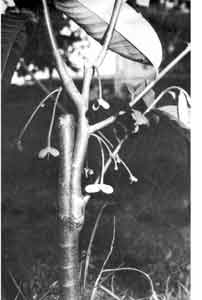 |
Left: A Rollinia deliciosa rootstock was planted during the summer and by the following spring had obtained a height of 2 metres. A good-quality Rollinia mucosa was chosen as the scion piece. A side veneer graft was used in which a shallow downward and inward cut was made into on side of the stem of the rootstock. A short second downward cut was made at the base of the first removing a piece of the bark. Rollinia has a thick bark; the first cut should only just expose the cambium layer and wood. A mature scion piece with dormant plump buds was cut to fit the rootstock and tied tightly with grafting tape. The open top of the taped union was covered with grafting wax. A plastic bag was placed over the scion piece and tied. Within a few weeks the buds of the scion piece started to grow. At this stage the rootstock can be cut off 50-100 mm above the graft union to induce vigour into the developing buds. When the new growth is about 100 mm long the plastic bag can be removed, and the tape removed when the first new growth has matured. | |
Right: A durian tree 3 metres high with four main branches was inarched with a named variety. A grafted tree from the nursery was planted beside the mature rootstock. A slice of bark, just into the wood and 30 mm long, was taken from both stems. The two cut surfaces were bound tightly together with grafting tape. The branches either side of the grafted one were cut off, the grafted branch stock was cut after the graft had taken. For strength a shoot was left to develop on one of the cut branches and this shoot was later approach grafted on to the named variety shoot. |
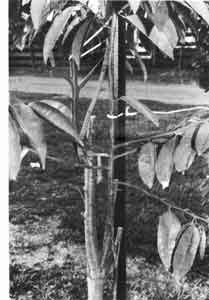 | |
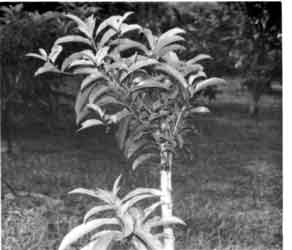 |
Left: A sapodilla was grafted using the side veneer method during the summer. The process was the same as used for the Rollinia except that several months were required for proper healing of the graft union. | |
Right: A star apple had two branches approach-grafted by placing a potted named variety tree on a scaffold beside the rootstock. Unlike the other grafts the stock was considerably larger than the scion. A slot the size of the diameter of the scion was made in the bark of the rootstock deep enough to expose the cambium layer. This graft should be done when the rootstock is actively growing and the bark slipping. A long shallow cut the same length as the slot in the stock was made on one side of the scion. This cut surface was laid into the slot cut in the stock and tightly taped. As shown the potted plant was removed when the grafts had taken and two ties remained for strength. Some shoots were allowed to grow on the stock and these will be grafted to the scion at a later date for additional strength. |
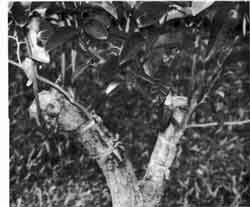 | |
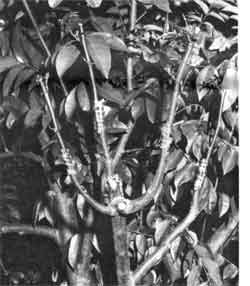 |
Left: A carambola was top-worked using a modified side veneer graft. A mature stock branch was cut off and four new shoots allowed to grow. On attaining 8 mm diameter they were cut off and the scions grafted on. Where the scions had 40 mm of new growth, a plastic bag previously placed on them was removed. The full wrap tape was replaced with a few tight turns of twisted tape for strength. |
DATE: January 1986
* * * * * * * * * * * * *
